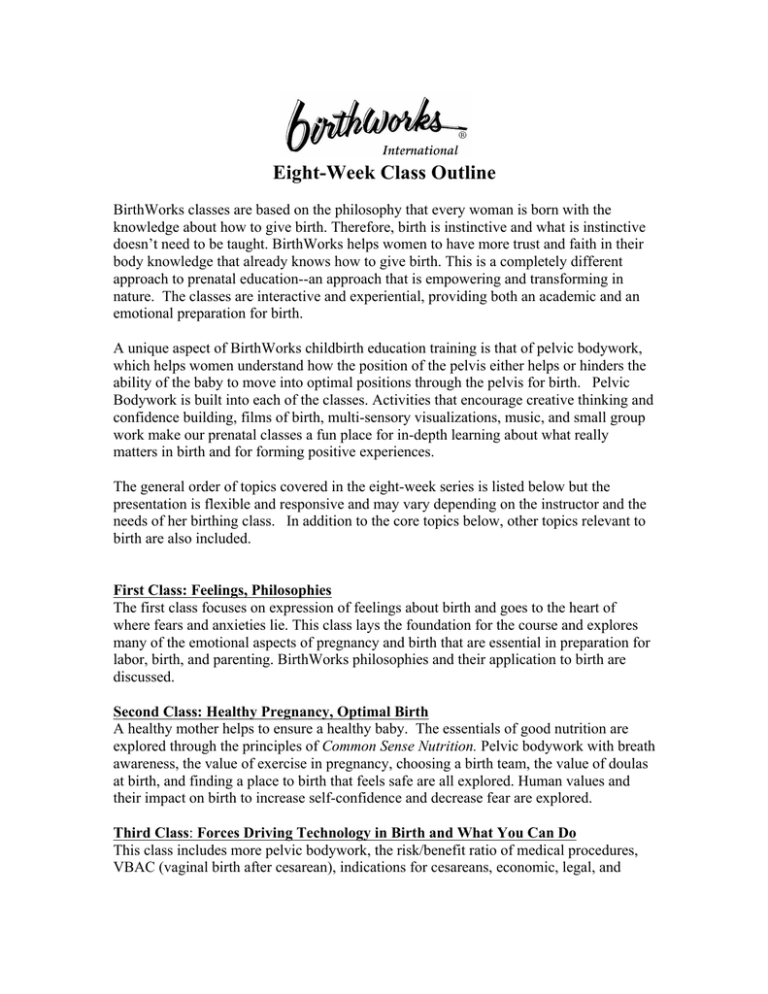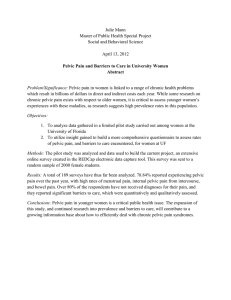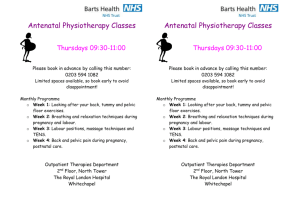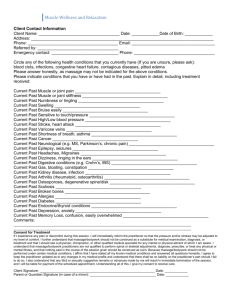Eight Week Class Outline
advertisement

Eight-Week Class Outline BirthWorks classes are based on the philosophy that every woman is born with the knowledge about how to give birth. Therefore, birth is instinctive and what is instinctive doesn’t need to be taught. BirthWorks helps women to have more trust and faith in their body knowledge that already knows how to give birth. This is a completely different approach to prenatal education--an approach that is empowering and transforming in nature. The classes are interactive and experiential, providing both an academic and an emotional preparation for birth. A unique aspect of BirthWorks childbirth education training is that of pelvic bodywork, which helps women understand how the position of the pelvis either helps or hinders the ability of the baby to move into optimal positions through the pelvis for birth. Pelvic Bodywork is built into each of the classes. Activities that encourage creative thinking and confidence building, films of birth, multi-sensory visualizations, music, and small group work make our prenatal classes a fun place for in-depth learning about what really matters in birth and for forming positive experiences. The general order of topics covered in the eight-week series is listed below but the presentation is flexible and responsive and may vary depending on the instructor and the needs of her birthing class. In addition to the core topics below, other topics relevant to birth are also included. First Class: Feelings, Philosophies The first class focuses on expression of feelings about birth and goes to the heart of where fears and anxieties lie. This class lays the foundation for the course and explores many of the emotional aspects of pregnancy and birth that are essential in preparation for labor, birth, and parenting. BirthWorks philosophies and their application to birth are discussed. Second Class: Healthy Pregnancy, Optimal Birth A healthy mother helps to ensure a healthy baby. The essentials of good nutrition are explored through the principles of Common Sense Nutrition. Pelvic bodywork with breath awareness, the value of exercise in pregnancy, choosing a birth team, the value of doulas at birth, and finding a place to birth that feels safe are all explored. Human values and their impact on birth to increase self-confidence and decrease fear are explored. Third Class: Forces Driving Technology in Birth and What You Can Do This class includes more pelvic bodywork, the risk/benefit ratio of medical procedures, VBAC (vaginal birth after cesarean), indications for cesareans, economic, legal, and financial incentives in birth, and informed consent. Participants are encouraged to accept more responsibility and to take an active role in planning their births. Fourth Class: Birth Physiology and Working with Labor Contractions Every woman is born with the knowledge about how to give birth. Birth is instinctive. This class includes discussion of the physical and behavioral aspects of hormones that are produced to help a woman give birth. In addition more pelvic bodywork is demonstrated and practiced and the risk/benefit ratio of obstetrical drugs is discussed. Nonpharmacologic ways of working with labor contractions, and comfort measures for birth are explored. Fifth Class: Your Amazing Body and Beliefs About Birth This class continues with pelvic bodywork defining the four principles of optimal pelvic positioning followed by analyzing the effectiveness of labor positions according to the four principles of pelvic bodywork. Belief systems and their impact on birth are explored and affirmations are developed to change those not conducive to positive birthing. l Sixth Class: Stages of Grieving, Healing Birth-Related Losses In this class the stages of grieving are discussed and men and women are given the opportunity to grieve a birth related loss This class is powerful and helps to facilitate normal and natural birth by releasing trauma from previous births and life experiences. Seventh Class: Labor and Birth, Mothers and Daughters Our mothers bring us into the world and our relationships with them have an impact on how we may give birth. In this class we explore mother/daughter relationships through experiential exercises. In addition, an auditory simulation of labor is intertwined with conscious birthing and labor terminology. A birth multisensory visualization lays down a memory of normal birth that can be accessed during labor. Eighth Class: After the Baby Comes, Primal Health The immediate postpartum period is a time when a new mother can exhibit primal behaviors that fulfill an innate fetal agenda. Mother/baby skin-to-skin contact is an experience of sensory integration and suckling helps to develop the baby’s limbic brain. The benefits of breastfeeding are presented and class participants learn the concept of “behavior is place dependent,” a concept crucial to primal health and our health as adults.





